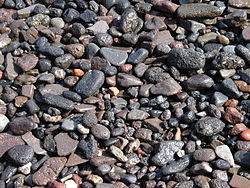Gravel
Gravel is small, loose, rock particles. It is any loose rock that is larger than 2 mm (0.079 in) in its smallest dimension (about 1/12 of an inch) and no more than 64 mm (2.5 in).
Small gravel is composed of granules (>2 to 4 mm/0.079 to 0.16 in). Large gravel is called pebbles (>4 to 64 mm/0.16 to 2.5 in).
Particles smaller than gravel are sand, larger particles are cobbles.
Gravel and sand are used for road surfaces, and for cement and Tarmac. Mixtures of gravel and sand mixed with various crushed material, are known as aggregate in the trade. This is used for drainage in the basement of roads, and other purposes. Mixture of stones and resin is also used to pave footpaths, driveways, etc. This mixture is known as Resin Bonded Gravel.[1][2]
Origin
Natural gravel comes from ancient beaches which have not consolidated (turned into solid rock). In effect, beaches from (for instance) the Jurassic are dug up in quarries. The material is then sifted into size categories. The gravel and sand is then sold on to engineering companies. Most natural sand and gravel is silica, SiO2, in its chemistry. This is very hard-wearing.
However, if the material is originally in hard rock form, then it is first crushed. This enables the industry to offer other materials such as granite or limestone, originally solid rock, as gravel.[3]
The open-cast mining and processing of gravel, sand and aggregate is a huge world-wide industry, sometimes called "conglomerates".
Gravel Media
A gravel road in Finland
Graded mechanically crushed stone, with particle sizes roughly between 5 and 15 mm
References
- ↑ "Resin Bonded Gravel". Resin Bonded Gravel. Retrieved 2020-10-29.
- ↑ "Resin Bonded Gravel". www.resinbondedgravel.org.uk. Retrieved 2020-11-16.
- ↑ "The Journey of Sand & Gravel: From Rome to the Streets". NM Ready Mix. 2018-09-28. Retrieved 2020-10-29.





